Portland’s exploding Liberty Bell
It’s the Saturday before the first Thanksgiving of the 1970s, and shit has been blowing up with alarming regularity.
Last month, a dynamite bomb at the University of Oregon in Eugene — the first of two bombings on campus this year — caused $50,000 in damages and, miraculously, no injuries. Ten days ago, state officials in Florence met the problem of an eight-ton marooned whale carcass with a half-ton of dynamite. That went just as spectacularly wrong as you would hope.
At 2:45 am, while most of the city sleeps, Jack Helm feeds three-by-seven-inch punchcards into City Hall’s new computer. In 1970, computers cost 4.6 million dollars, are as big as Volkswagons, and almost as fast. They work round-the-clock and need constant human attention. So when the night shift job opened up, Helm jumped at the opportunity. He prefers solitude over socializing, machines over people. No chitter-chatter around the water cooler. No citizens wandering about with their pothole complaints. Just his quiet and his machine.
Completed in 1895 and modeled after the Russian Kremlin, Portland City Hall was one of the country’s first examples of steel frame construction — walls carry the floor and roof loads, allowing for more open interior spaces. Ornamental interior columns were made with scagliola, an imitation marble made by applying dyes and threads to drying plaster in a process so labor-intensive, it would cost more today than real marble.
Light snow falls on the ghost of a downtown as the last of the late-night drinkers slide into their cars and drive slowly home. Soon, the bread trucks and the newspaper trucks will hit the road, laying down the foundation for another day.
In City Hall’s east portico on the first floor, custodian Leslie Graham — the only other person in the building — guides his floor buffer past the Liberty Bell Replica for the third time, giving the seventy-five-year-old marble floor a near mirror shine.
The Portland Liberty Bell — an exact replica of the famous Philly bell — has graced City Hall for six years, protected from the elements and the birds, dusted faithfully by Graham and seldom rung.
Patriotic fervor
In 1963, retired businessman Henry Casey mistakenly believed no other Liberty Bell replicas existed (Salem got theirs in 1950, as did every other state). Rightfully, he thought Portland deserved their own.
Casey’s Liberty Bell Committee launched an ambitious campaign to cover the bell’s $9,000 price tag through private donations. If funded by June 20th, the bell would be cast at the McShane Bell Foundry in Baltimore, Maryland, and shipped to Portland in time for Independence Day.
Two days before the deadline, the committee ran an ad in the Portland Reporter imploring readers to “bring back a revival of that patriotic fervor we knew as youngsters.“ Donations could be sent to P.O. box 1776.
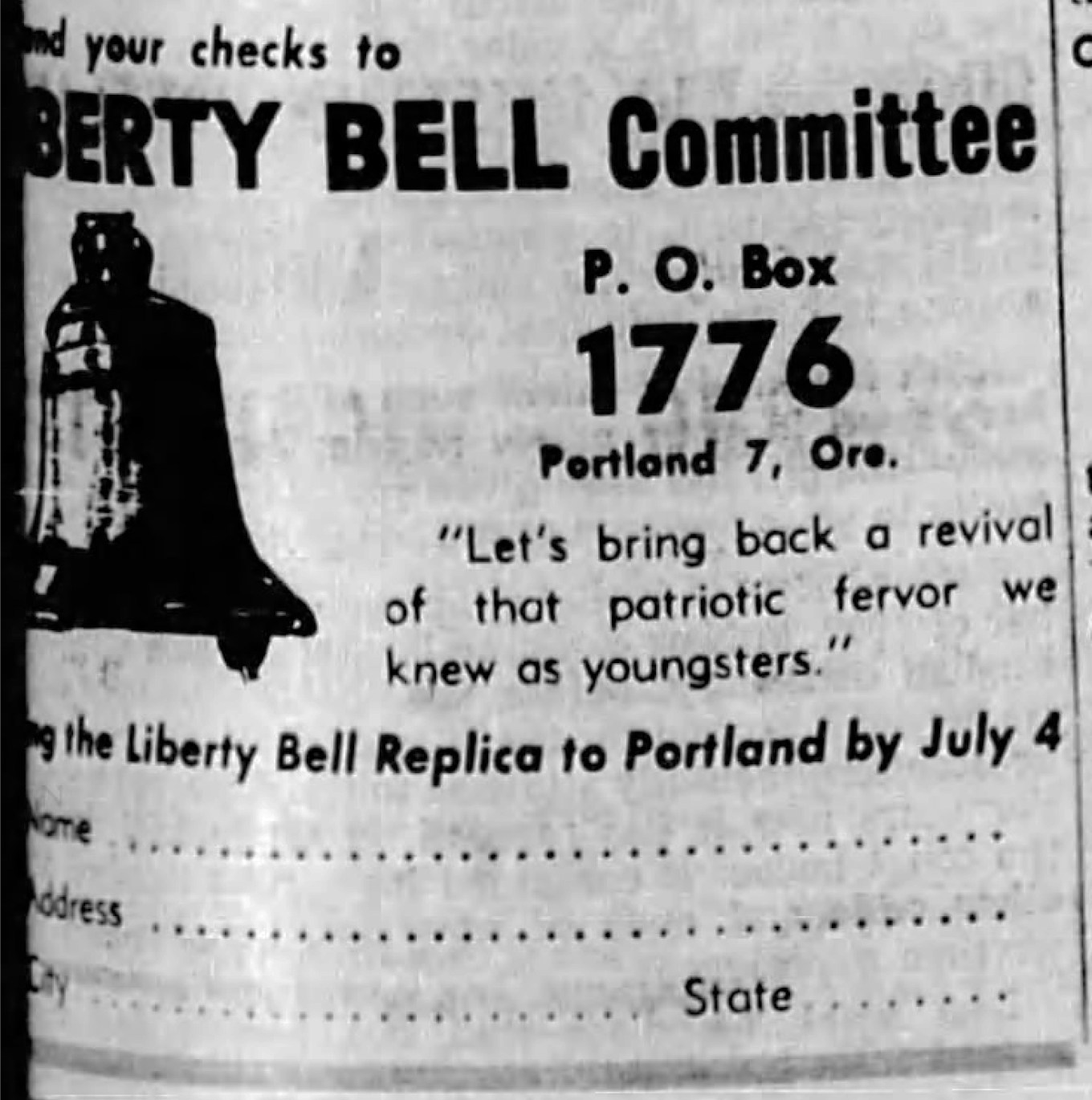
An accompanying article reminded Portlanders they raised $30,000 to buy a small elephant the previous year — and this is a full-size bell after all. The late push did the trick. Arriving with no time to spare, the Portland Liberty Bell was hastily mounted on a flatbed truck and paraded around town for July 4th. The committee hadn’t yet found a permanent home for their bell, so it sat in storage until May 5th, 1964, when it made its City Hall debut.
In the still of the night
Graham has also come to enjoy the night shift. Not for the solitude, but because night shift is when the real cleaning gets done. Day shift is an exercise in futility: removing smudgy fingerprints from glass doors as new people leave new smudges on the doors you’ve just cleaned; watching the clueless carrier of a dripping umbrella walk down your marble hall; following stealthily in their wake, scooting a towel with your foot. At the end of the day, you’ve worked your ass off to maintain the status quo. On the night shift, you can stand back and admire a job well done every night.
City Halls, like State Capitols, are well-used and well-polished institutions — shining buildings on the hill. Three hours from now, Graham will hand the building back to the man who runs it. Mayor Terry Schrunk — first elected in 1957 on a platform of urban renewal — will give the custodian an appreciative nod as they pass in the hall. Early Sunday morning is the perfect time to prepare for the week ahead. No meetings. No phone calls. Just three solid hours of mayoring before church.
At 2:55 am, Graham guides his buffer out of the portico and down the hall. In a flash, the entire building — the entire city, it seems — lights up as bright as day. An unnatural, perverse day that lasts a second and feels like the end of time. A sick metallic pang assaults the senses.
Helm looks up from his punch card as a three-inch piece of shrapnel — seconds ago, it was Liberty Bell — bursts through the floorboards and through the ceiling. Then, like a magic bullet, the Liberty Bell shard changes direction, hurling fifty feet down the third-floor corridor until it’s lodged in the door of a three-quarter-inch steel safe.
The concussion blasts out half the windows in City Hall, blows doors off their hinges and topples the mayor’s heavy wood desk. Windows shatter across the street and as far as three blocks away. Total damages come to $170,000. The price tag would be higher if the entire block facing City Hall weren’t already slated for demolition as part of Schrunk’s urban renewal.
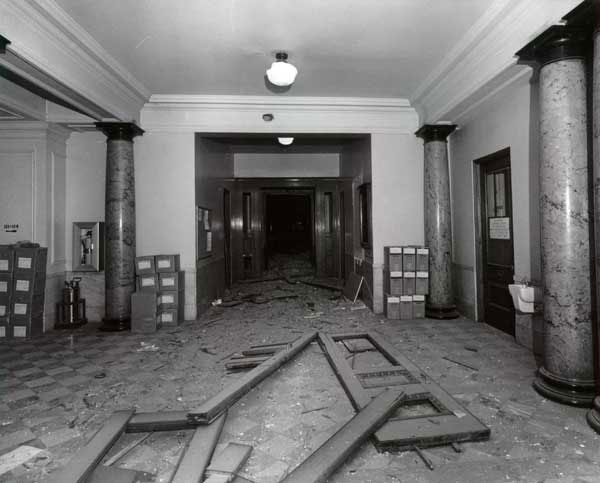
In the portico’s adjoining room, Graham is hit in the leg by a falling beam but otherwise unscathed. Unable to see through the cloud of dust, the custodian fights the instinct to flee, slowly feeling his way up to the second floor. There, Helm is shaken but unharmed. Both men find their way to the street as the first of the first responders arrive.
As the dust settles where Portland’s Liberty Bell stood shining and bright — there is now a smoldering pile of debris a foot deep. And no Liberty Bell. The largest remaining piece of the bell, a 24” x 16” portion of the lip sits a few yards away, reverberating and hot to the touch.
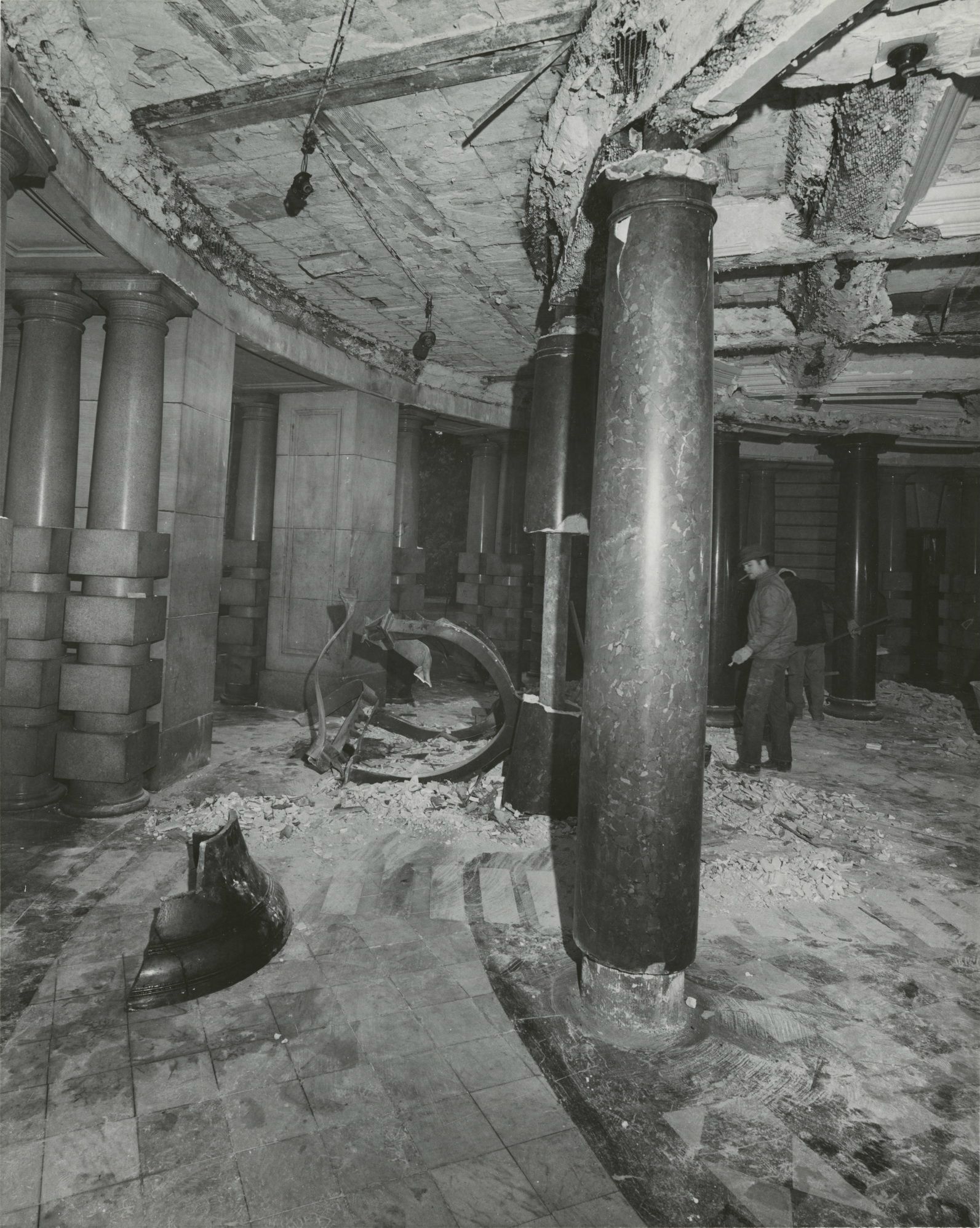
Portland Police cordon off the area, fearing a second bomb. The FBI is on-site within a half hour. They will be joined by Multnomah County Sherrif’s deputies, an Army demolitions team, military investigators and firefighters from the District of Columbia.
Understandably, Terry Schrunk took the attack on his building and the destruction of his bell personally. “It’s a sick thing,” the mayor said, surveying the damage “(I’m) extremely unhappy that such a thing could happen in our own city or another.”
Police initially describe the explosion as a dynamite bomb but quickly backpedal. FBI special agent Julius Mattson would not comment on the type of explosive used “(it) would be disadvantageous to what we are trying to do,” he told reporters.
Long-haired freaky people
Helm and Graham report no suspicious activity. A $500 reward offer nets dozens of tips: drug dealers, mafia, disgruntled city workers, kids who like to blow shit up. Within hours — in time to make the day’s newspapers — police have a profile of their suspect: hippies.
Specifically, police want to talk to four white men with shoulder-length brown hair who were seen circling the building in a white Volkswagon microbus around the time of the explosion. Within two days, the men are identified, interviewed and cleared. While those four hippies are no longer suspects, the VW Microbus remains an object of interest, curiously changing color several times throughout the investigation. A few months after the blast, police ask the FBI for a list of all blue or red VW Microbuses registered in California.
Upon learning of the suspect vehicle, high school senior Susan Gates reports having seen a tall, bearded, young white man with shoulder-length brown hair driving said Microbus near City Hall around the time of the blast. The teen picked one man out of a book of black and white surveillance photos. Police later identified him as a known member of the militant Patriot Party.
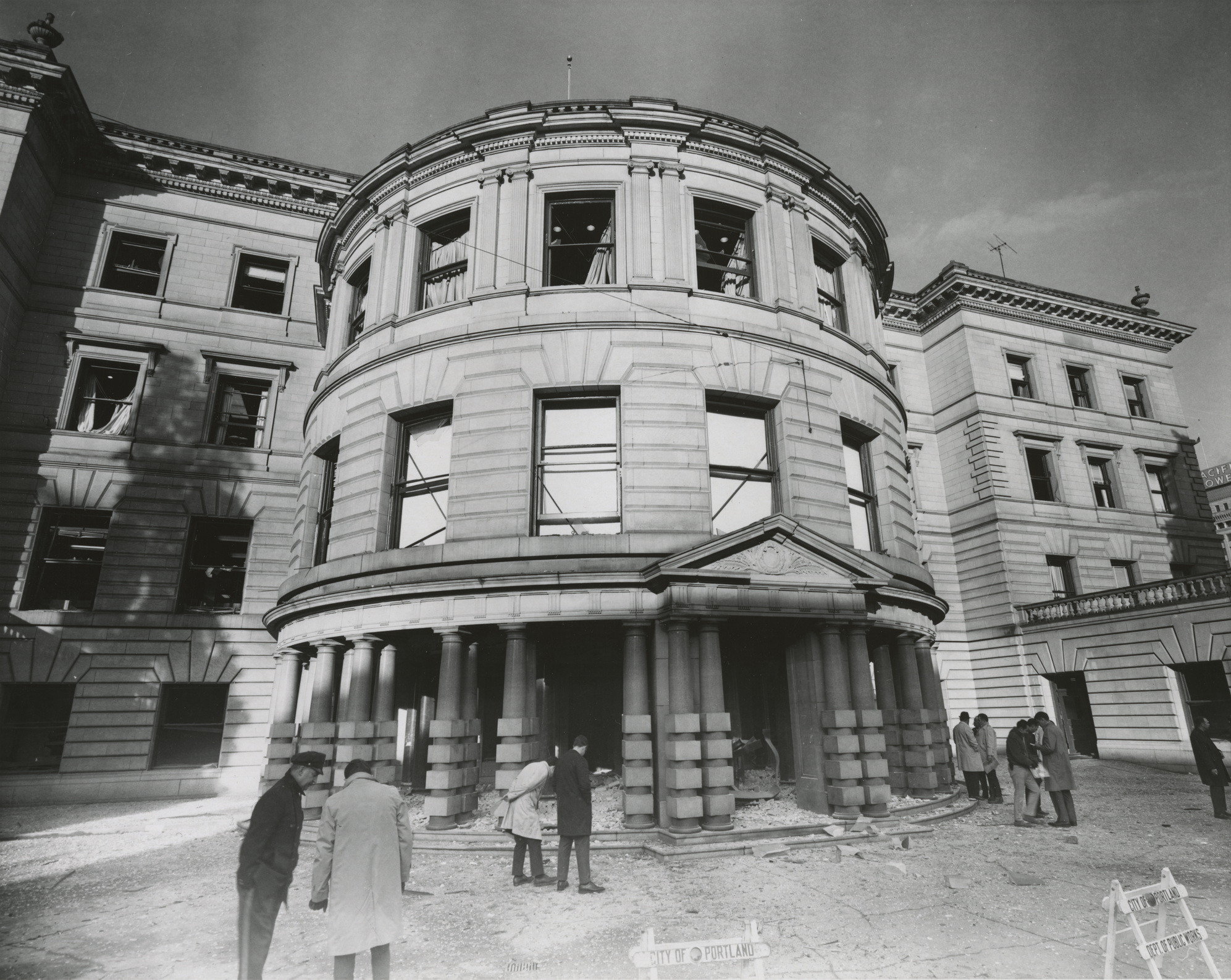
Twenty-four cases of dynamite
A month before the Liberty Bell blast, Albert George Odermatt, a guard at the Snow Peak Logging Camp, 70 miles south of Portland, was murdered during the robbery of twenty-four cases of dynamite. Some of the dynamite was recovered on the side of the road two miles from the camp. The rest, reportedly, was otherwise accounted for.
Since the heist, police have been surveilling a blue and gray VW Microbus seen near the remote logging camp and the man driving it — the same man Susan Gates identified. Police interviewed him about the Liberty Bell bombing. He provided a solid alibi and was released. This would be as close as police would come to an arrest in either case.
Nearly 50 years later, it’s tempting to believe police had their man and let him go: the dynamite, the microbus, the long-haired white guy, the Patriot Party — all the pieces fit. He must have manufactured an alibi. But this is 1970, and shit is blowing up all over the place. Long-haired freaky people are everywhere. And they all drive VW Microbuses.
Three men and a Canadian
This wasn’t even the first time the counter-culture hatched a plan to dynamite the Liberty Bell. Five years prior, three Americans — members of the Castro Black Liberation Front — and a Canadian TV personality were arrested in New York for plotting to blow up the Liberty Bell. The Liberty Bell, along with the considerably larger and harder to blow up Washington Monument and Statue of Liberty. The case was cracked by NYPD patrolman Raymond Wood, who infiltrated the group, earned their trust and thwarted the attack.
North of the border, four additional Canadians were arrested for their involvement in the plot. During their trial, it was revealed that 46 sticks of dynamite and “a goodly supply of detonators” were still unaccounted for. This was 1965, and shit was just starting to blow up.
The (white) foreign terrorist who crossed the border with 22 sticks of dynamite and a plan to destroy national treasures rolled on her co-conspirators in exchange for a five-year sentence. The three (Black) Americans each got ten years.
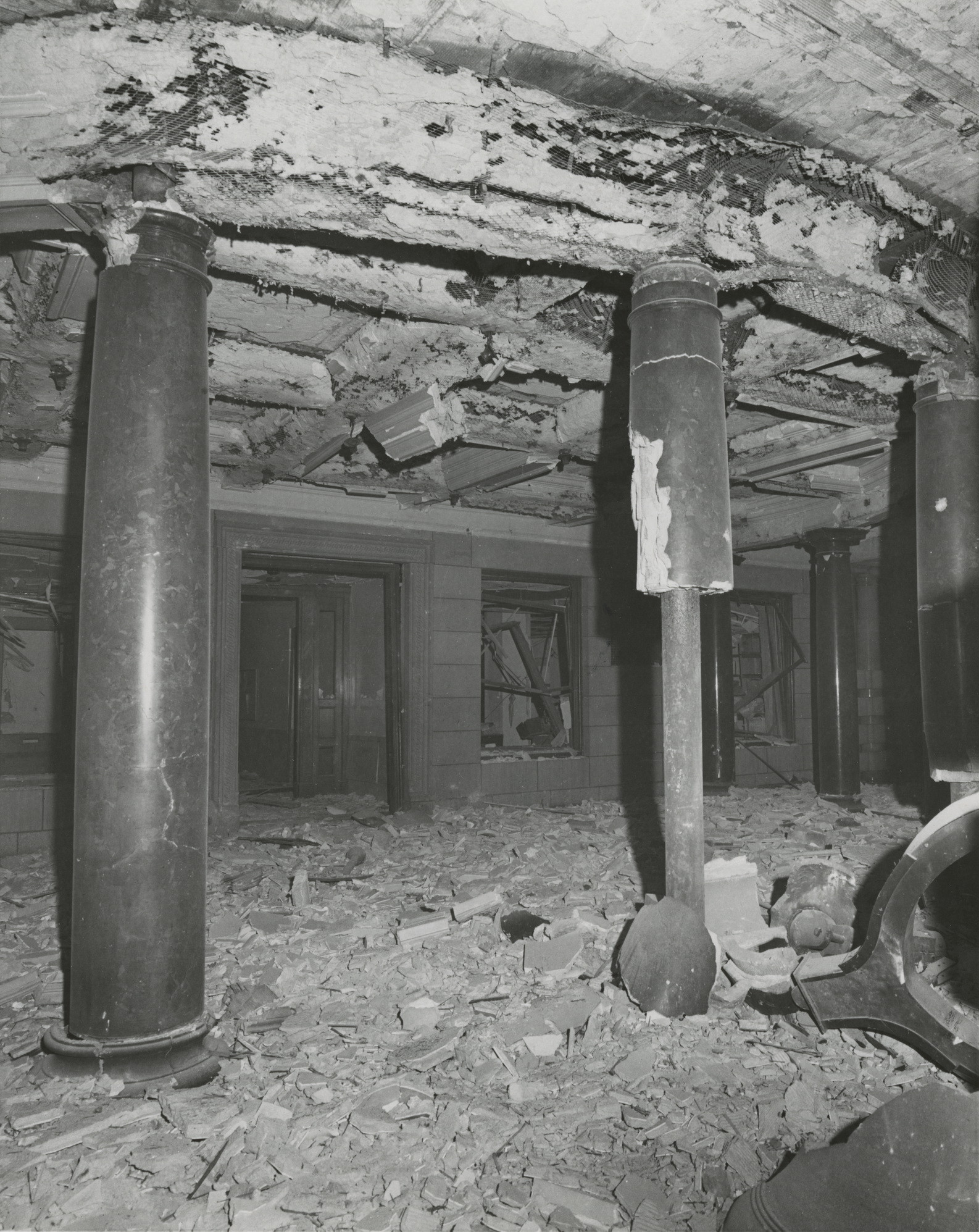
Thirty-six boxes in a barn
In 1970, there was no internet, no cameras on every street corner and in every pocket, no facial recognition software, no Patriot Act. Police relied on old-fashioned gumshoe techniques and often thwarted crime by infiltrating suspicious groups as Officer Wood had done in New York when he saved the Liberty Bell’s life. Police investigated groups and individuals suspected of criminal activity along with those who looked like they were up to no good, at times violating the very laws they were enforcing.
The extent to which Portland police broke the law to protect the order would not be fully known until 2002, when an anonymous tip led Portland Tribune reporters to a nondescript barn out on the edge of town. Despite the best efforts of mice and mold to return them to their natural elements, there sat thirty-six boxes of police counter-terrorism files.
A 1981 Oregon law made it illegal for police to collect files on people and groups not suspected of a crime and required the destruction of all such existing files. Instead, longtime patrolman and counter-terrorism specialist Winfield Falk illegally took Portland PD’s newly illegal surveillance files into his own possession. He continued to access and add to the files over the years. Falk died at fifty-three in 1987 and was remembered as a dedicated cop and world-renown expert on global terrorism.
All told, the files contained 851 manila folders with information on 576 organizations and over 3,000 individuals, including Vera Katz, Portland mayor at the time of the discovery. Surveillance photos showed her supporting a grape boycott in 1968.
The Tribune ran a series titled the Secret Watchers, which revealed a clear police bias against left-leaning groups. Falk — himself a member of the John Birch Society — worked obsessively to connect left-leaning and African American groups to Communism.
The files are now preserved for history, a documentary glimpse at a time when the Portland Bureau of Police spent a lot more time investigating counter-culture groups than chasing terrorists. Amidst investigations of groups like the ACLU, the Ecumenical Ministries of Oregon, and a local rape hotline, police occasionally hit paydirt. Surveillance files aided in the capture and conviction of four people involved in the bombing of two military recruitment centers.
The boxes included a file on the Liberty Bell bombing but revealed nothing that might help solve the nearly fifty-year-old mystery.
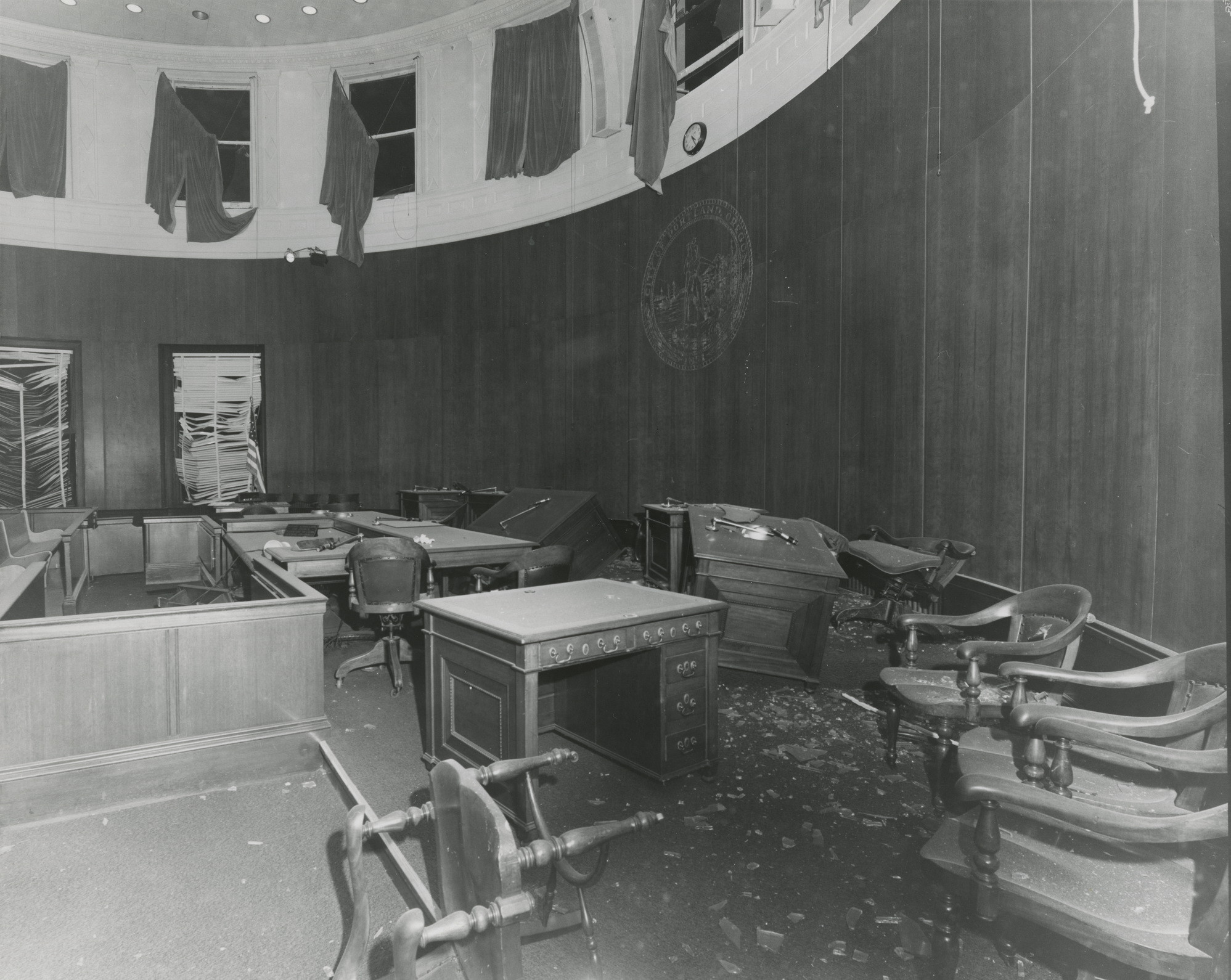
Unusual suspects
If the police were only seriously looking for hippies, did they overlook other possible suspects? Could the bomber have been motivated by something other than protest or pranksterism? Who else would have had a reason to blow up the Portland Liberty Bell? A lot of people, as it turns out.
When we think of organized crime, we think of the east coast, Chicago and Las Vegas. But in the late ’60s and early ’70s, Portland was a hotbed of vice and underworld activity. The city itself was built on a gamble back in 1845. When the two founders couldn’t agree on a name, a best-of-three coin toss solved the debate. Heads, their new city would be called Portland. Tails, it would be Boston. The city never really stopped gambling.
$500 in an envelope
In 1957, Terry Schrunk, the newly-elected mayor of Portland, found himself in the national spotlight and in the crosshairs of the U.S. Senate Labor Rackets Committee. Schrunk was called to DC to appear at a nationally televised hearing.
The focus on Schrunk stemmed from an incident in 1955 when he was the Sherrif of Multnomah County, which includes the city of Portland. Schrunk and his deputies raided an illegal gambling and after-hours drinking joint. They arrested a few drunks but none of the proprietors. Crime boss Big Jim Elkins, who ran the club in question, testified that a manager put $500 in an envelope and left it outside the club. The envelope disappeared. The joint continued operating. The implication: in Portland, Oregon, law enforcement is in the pocket of organized crime.
Schrunk denied all accusations and then went on to fail a Secret Service polygraph test, walking out mid-test and decrying it as a fishing expedition. Lead Senate counsel Robert F. Kennedy traveled to Portland to testify against the mayor before a grand jury. Despite Kennedy’s charm offensive, the hometown jury acquitted their mayor of all bribery charges.
A message loud and clear
If the mayor was, as Kennedy and the Senate contested, under the undue influence of organized crime, did he try to break from that influence in 1970 as part of his efforts to clean up the city? It takes only a short conspiratorial journey to believe the Liberty Bell bombing was not a war protest but a loud and clear message of intimidation from the mafia to Schrunk: You’re not cleaning us up. We can blow you up. And we can blow up your house, too.
Though Schrunk beat the rap, the racketeering specter would haunt him throughout his tenure.
An inside job
In 1969, Portland Police Sergeant Roger Haven filed a report in which he claimed the owners and patrons of illegal gambling halls “apparently felt they enjoyed an immunity to police action because of political influence the owners, operators and some patrons exert over some unnamed figures in city government.”
Haven and two other officers testified that Vice Squad Lieutenant Jack Strudgeon told his officers to stop making arrests in gambling houses. The allegations claimed the Lieutenant told his men the gambling house operators had “great political influence on political powers in the city. As a personal favor to me, stay out of the card rooms.” Strudgeon allegedly threatened the officers with being transferred or given undesirable assignments if they didn’t comply.
Before a grand jury in Portland, Strudgeon denied ever giving such orders, which promptly earned him a perjury indictment. Strudgeon beat the rap. The three officers who testified against him were transferred. Two received three-percent pay cuts. The Portland Police Association immediately fought the transfers, claiming they were politically motivated. An association spokesperson directly accused Schrunk, claiming, “the mayor and his agents wrongfully transferred and demoted three police officers in violation of their rights.”
Efforts to overturn the transfers were unsuccessful. Haven continued to serve and protect in a state of limbo along with his co-plaintiffs, Sergeant Wayne Inman and Patrolman Specialist Winfield Falk — the same Winfield Falk who would go on to stash those thirty-six boxes in that barn.
The nature of a perjury trial indicates that someone on the police force was lying about illegal gambling houses. Either Lieutenant Strudgeon lied when he denied giving his officers orders to stand down, or his officers lied when they said he gave them the orders.
Could a civil servant have become so disgruntled with the seemingly unpunishable activities of their bosses, they took out their frustration in the city’s most public space? Against the country’s most powerful symbol? As with the mafia intimidation theory, it takes only a short conspiratorial journey to think a rogue cop could have blown up the Liberty Bell. Someone obsessed with terrorist bombings. Someone who’d raise no suspicion at City Hall in the middle of the night. Someone really good at keeping secrets. Someone who couldn’t handle orders to turn a blind eye to mobsters. Someone so dedicated to his vision of right and wrong that he’d break the law to enforce the order. Someone who wanted to send a clear message to the mayor: either play by the rules — all of them — or all the rules are off. Anarchy in the PNW.
unsolved mysteries
As a broader picture emerges of Portland in 1970, it starts to look like anything was possible. A lot of the hippies were good guys. Some of the good guys were bad guys. And a lot of the bad guys had long, fruitful careers eluding justice.
If someone knows something, no one’s talking. The crime carried only a five-year statute of limitations, so if someone was inclined to talk about the time they blew up the Liberty Bell, they’ve missed out on decades of bragging. Odds are, whoever did it didn’t tell anyone. The counter-culture teens of 1970 went on to shape the culture and are now retirement age. The authority figures of 1970 are now dead.
The city ordered a replacement Liberty Bell from the McShane foundry, then refused to pay for it. Their new Liberty Bell had a crack. Not the shallow ornamental crack carved into the exterior, but a microscopic crack, eight inches from the rim, running along 80% of the bell’s circumference.
The city and the foundry argued for three years and settled on a $2,000 discount. In 1975 Portland’s second Liberty Bell found its first home, a park across the street from City Hall where blighted old buildings once stood, the newly christened Terry Schrunk Plaza.
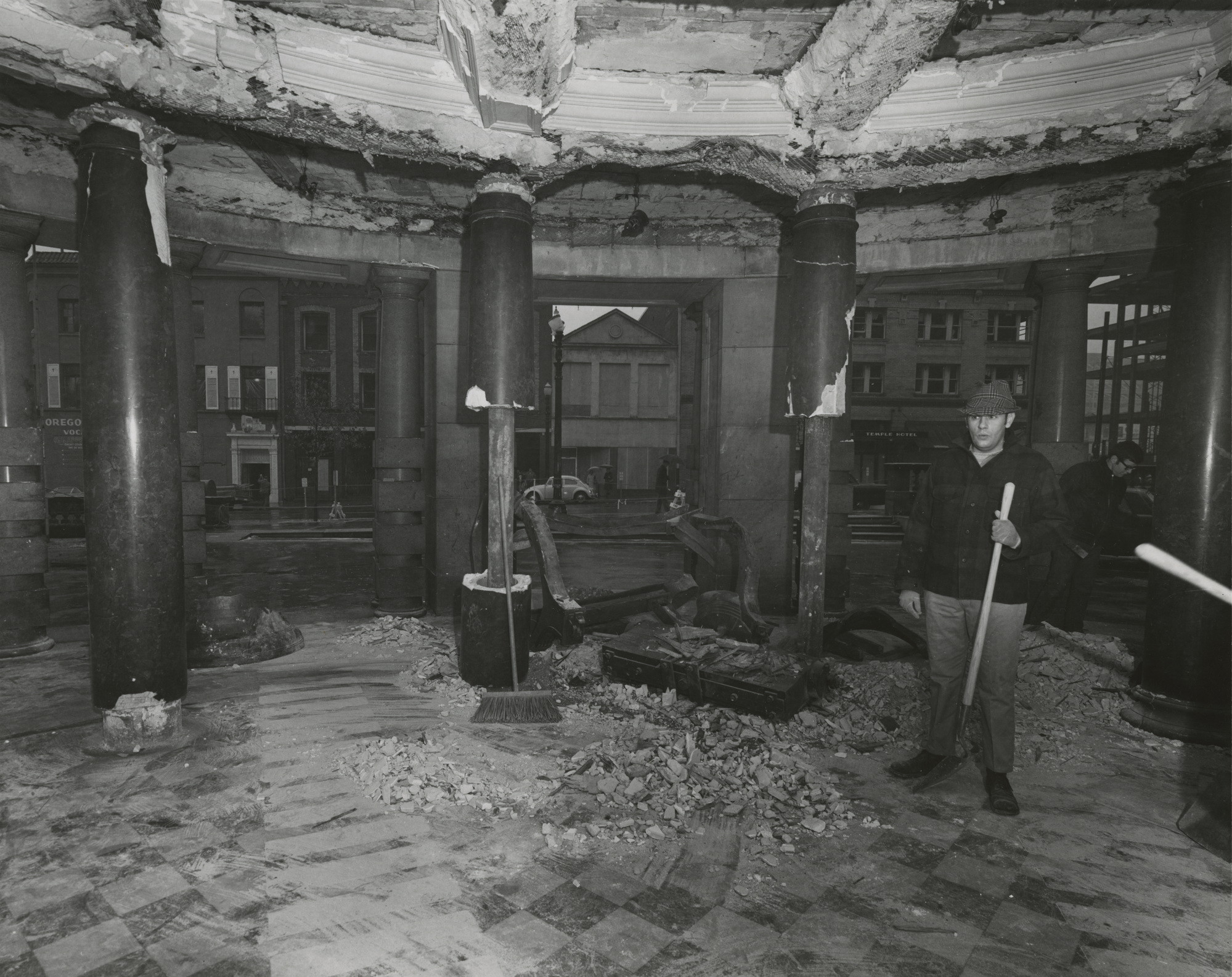
Resources: KGW8, Portland Oregonian, Portland Tribune, Oregon Encyclopedia, Street Roots, Newspapers.com
Note: I have sought to relay all pertinent facts related to this story as accurately as possible, based on cross-referencing news coverage and police reports. For some character elements, namely the name of the computer tech and how those involved may have been feeling at the time, I took some creative license to fill out the story.

Wow would be nice to know the truth. I will never think of that mayor as a good guy. Thank you,